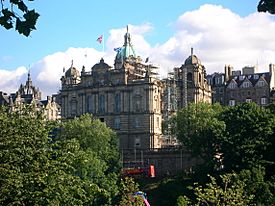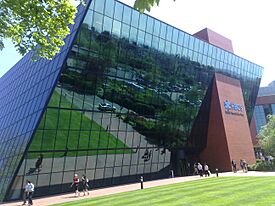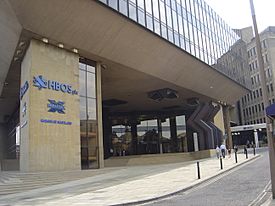HBOS facts for kids
 |
|
| Subsidiary | |
| Industry | Finance and Insurance |
| Fate | Acquired by Lloyds TSB |
| Founded | 2000 |
| Headquarters | |
|
Key people
|
James Crosby & Andy Hornby (former Chief Executives) Lord Stevenson of Coddenham (chairman) |
| Products | Financial services |
|
Number of employees
|
72,000 |
| Parent | Lloyds Banking Group |
| Subsidiaries | Bank of Scotland plc, HBOS Australia, HBOS Insurance & Investment Group |
HBOS plc was a major banking and insurance company in the United Kingdom. It is now completely owned by the Lloyds Banking Group, which took it over in January 2009. HBOS was the parent company for well-known UK banks like Bank of Scotland and Halifax.
The company was created in 2001 when Halifax plc and the Bank of Scotland merged. This merger was a big deal because it created a new, powerful company that could compete with the "Big Four" banks in the UK. At the time, HBOS was also the country's largest lender for home loans, known as mortgages.
Although the name HBOS wasn't officially short for anything, most people believed it stood for Halifax Bank of Scotland. The company's main headquarters was in Edinburgh, Scotland, while its operations headquarters was in Halifax, England.
On January 19, 2009, HBOS was bought by Lloyds TSB. This happened after shareholders from both banks agreed to the deal. Today, HBOS is part of the larger Lloyds Banking Group.

Contents
The Story of HBOS
How HBOS Was Created
HBOS was formed in 2001 through a merger between two large financial companies: Halifax and the Bank of Scotland. Halifax had recently changed from a building society (a type of financial institution owned by its members) to a public company. The merger created a new "fifth force" in British banking.
In 2006, the company simplified its structure through a special Act of Parliament called the HBOS Group Reorganisation Act 2006. This act allowed the Bank of Scotland to become the main banking business of the group. The Halifax brand name was kept, but it began operating under the Bank of Scotland's banking license.
Facing a Financial Crisis

In early 2008, the world faced a major financial problem known as the credit crunch. This was a difficult time for banks everywhere. In March 2008, false rumors spread that HBOS needed emergency money from the Bank of England. This caused HBOS's shares on the stock market to drop in value.
On September 17, 2008, the bank's share price moved up and down wildly. Even though the government's financial authority said the bank was stable, people were worried.
Later that day, the BBC reported that HBOS was in talks to be taken over by another large bank, Lloyds TSB. The goal was to create a "superbank" and prevent HBOS from failing, which could have been very bad for the UK's economy. The government even agreed to let the takeover happen without the usual checks for fair competition, because it was an emergency.
Alex Salmond, who was the First Minister of Scotland at the time, was angry about the situation. He blamed "speculators in the financial markets" for forcing the bank into a merger.
The Takeover by Lloyds TSB
On September 18, 2008, the details of the takeover by Lloyds TSB were announced. The deal was officially completed on January 19, 2009. For the takeover to happen, shareholders from both HBOS and Lloyds TSB had to vote to approve it.
The Prime Minister at the time, Gordon Brown, was personally involved in arranging the deal. After the takeover, the new, larger company was named Lloyds Banking Group. The former leaders of HBOS later said they were very sorry for what happened to the bank, which affected shareholders, employees, and taxpayers.
The Government Bailout
To prevent a total collapse of the UK's banking system, the British government took a major step. On October 13, 2008, the government announced it would put £37 billion of new money into three major banks: Royal Bank of Scotland, Lloyds TSB, and HBOS. This action is often called a "bailout."
The government explained that this was not a normal case of public ownership. The plan was for the banks to be returned to private owners once the financial system was stable again. In exchange for the money, the government became a major shareholder in the banks, owning about 40% of the newly combined Lloyds and HBOS group.
Investigation into the Bank's Failure

In 2015, an official investigation looked into why HBOS failed and needed a bailout. The report blamed the bank's top executives for taking too many risks. It said the bank's leaders focused too much on growing quickly and making short-term profits, especially in risky property loans.
The investigation found that the bank's board of directors did not have enough banking experience to challenge these risky decisions. This made HBOS very weak when the global financial crisis hit.
Later, in 2019, the Bank of Scotland was fined £45.5 million. The fine was for failing to report dishonest activities that had happened at one of its branches years earlier. The bank received a discount on the fine because it agreed to settle the case.
What HBOS Owned
HBOS ran its business through several divisions and brands.
Banking Brands
Bank of Scotland plc was the main banking part of the group. It operated many well-known brands in the UK, including:
- Bank of Scotland
- Halifax
- Birmingham Midshires
- Intelligent Finance
- Sainsbury's Bank (a 50% share, which was later sold)
It also had international operations in countries like Spain, Ireland, and the Netherlands, though many of these were later sold or closed.
Other Businesses
- HBOS Australia: This division managed the group's businesses in Australia, including Bankwest. Most of these were sold to other banks.
- HBOS Insurance and Investment Group: This part of the company handled insurance and investment products. It included brands like Clerical Medical and St. Andrew's Group.
See also
 In Spanish: HBOS para niños
In Spanish: HBOS para niños


